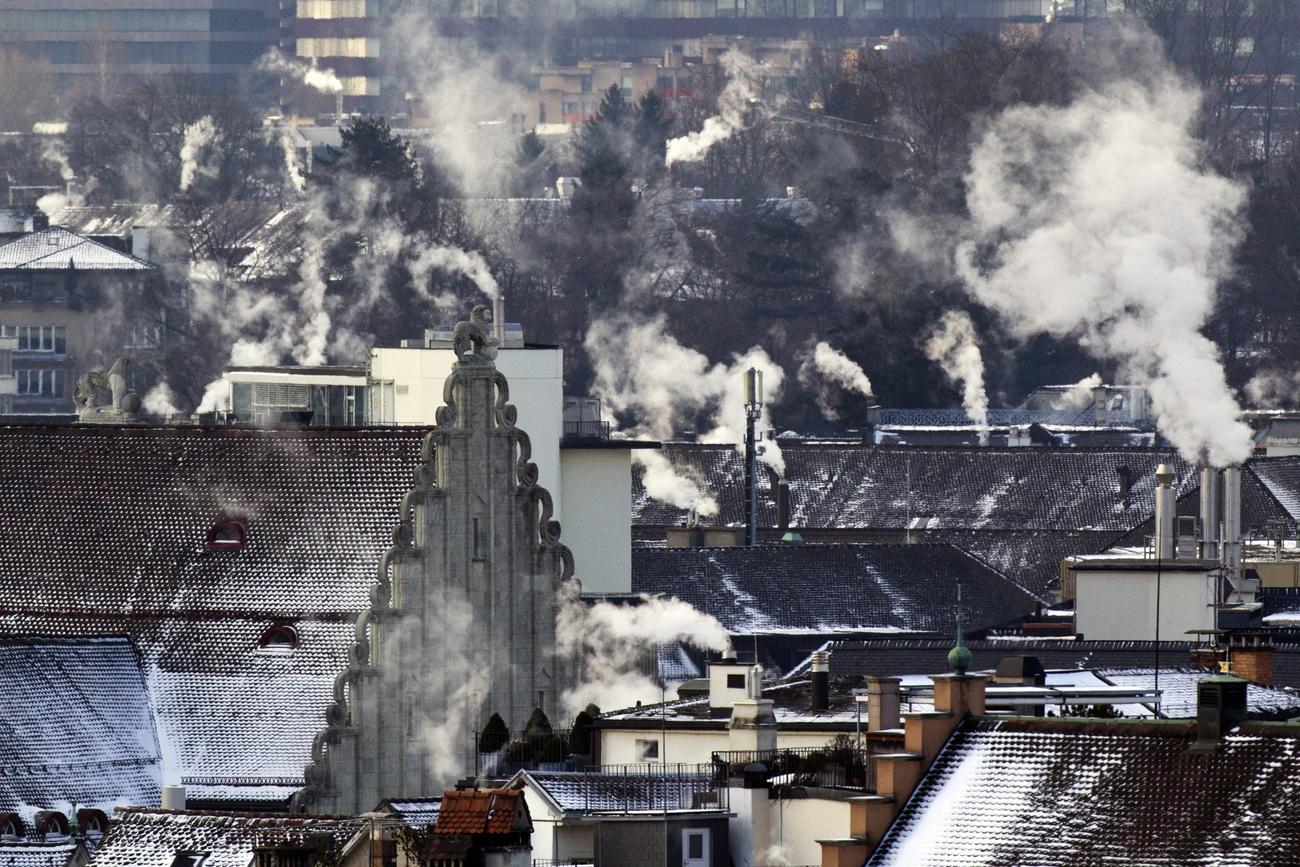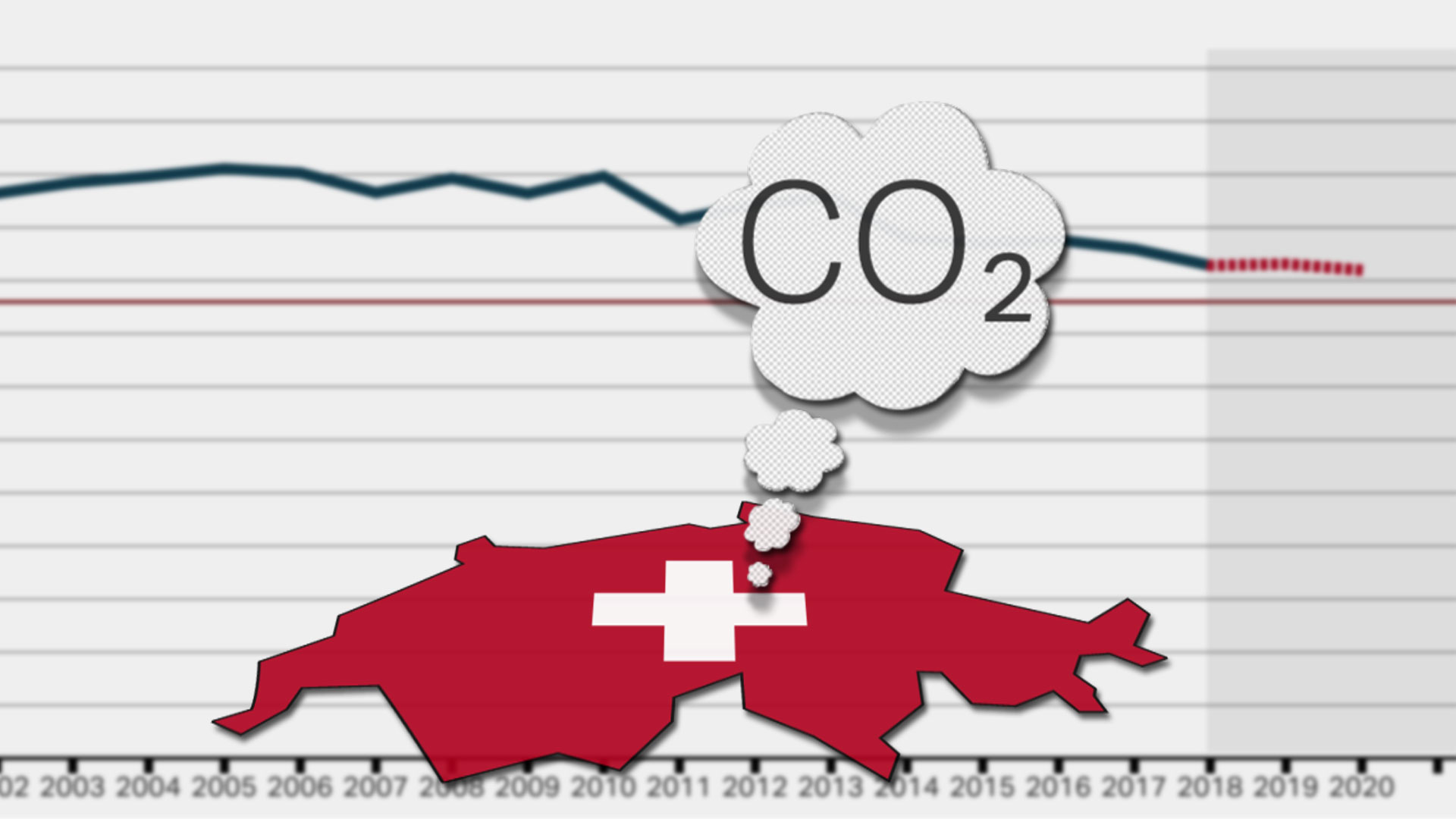
Switzerland misses its emissions targets

Switzerland’s emissions have declined over the last 30 years, but not enough to meet the national targets set for 2020. What’s behind the gap?
By 2020, greenhouse gas emissions in Switzerland should be down by 20% from what they were in 1990. That’s the target outlined in the federal CO2 law.
While figures are only available until 2018, the federal environment office expected that, based on current projections, Switzerland will fail to meet its national targets. Not even the temporary slowdown of activity caused by the coronavirus crisis will help.
Since 1990, Switzerland’s emissions have declined by 14%, whereas the population has increased by 27%. The level of emissions varies depending on the economic sector involved, as the chart below indicates.
One trend that has emerged over time is that the bulk of emissions no longer come from the building sector, but rather from transportation. Note too the increase in the rate of “synthetic” gases, which includes products used in refrigerators and spray cans, considered alternatives to products that harm the ozone layer.
Heat pumps instead of heating oil
A closer study shows that there has been a marked reduction of emissions in the building sector. Improved energy efficiency and replacement of old oil-fired heating systems have reduced the emissions from houses and buildings by 34%.
Despite more use of heat pumps and solar heating, the potential to bring down emissions from buildings, especially older buildings, remains considerable.
Among countries in Europe, Switzerland uses oil for heating the most, and at present only 1% of houses are adapting to new energy standards each year. At this rate, it would take another hundred years to convert all the buildings in Switzerland.

More
Why most Swiss buildings are environmentally inefficient
Fewer cows, fewer farms
Agriculture, which generates a seventh of emissions in Switzerland, has also made reductions since 1990 (-10%). Over the years, there has not only been a decline in the total land area used for agriculture, but also in the numbers of cattle being raised, which contribute to the greenhouse effect by producing methane gas.
The decline in animal herds and in use of mineral fertilisers brought down the emissions from agricultural production by about 8% between 1990 and 2011, according to Hannah Hofer, who is head of energy and environmental affairs for the Swiss Farmers’ Union. At the same time, she told swissinfo.ch that emissions from the agrifood sector have gone up (by 15%).
Due to the sheer complexity of biological processes, whether in the digestive system of large animals or in organisms that live in the ground, it is not easy to achieve major reductions in emissions from agriculture, Hofer insists. For farms, climate protection goals may conflict with other goals being pursued by the farmer, such as animal welfare, security of food supply or reduced use of plant health products.
According to the farming industry association, major reductions in agriculture are feasible only at the expense of food production. For example, a reduction in the number of cattle would would require a drop in consumption of animal products, says Hofer.

More
Switzerland misses the greenhouse gasses target
Bigger, more powerful cars
Offsetting the reductions achieved in the building sector, agriculture and manufacturing – where there has been a drop of 14% – is road traffic, where emissions have increased somewhat (+1%).
There are several reasons for this. Most of all, there are more vehicles on the road than there were 30 years ago. There are 4.6 million cars in the country, which is an increase of around 50% compared to 1990.
In contrast with other countries in Europe, Swiss drivers favour bigger and more powerful vehicles. In Switzerland, SUVs now make up about half the number of cars on the road, whereas the European average is about a third.
The increase in the proportion of diesel engines, which emit less CO2 than petrol engines, technological innovations in the auto industry and an increase in the number of electric cars have all played a role in bringing down emissions.
However, the failure to meet CO2 standards in new cars, as well as the increase in the number of kilometres being clocked by drivers on roads, have put the emissions reduction target from transport (-10% compared to 1990) out of reach.
Fear of catching the coronavirus on public transport has put many citizens back behind the wheel or on motor scooters, as reported in a study by the Deloitte Switzerland consulting firm published in April. It is likely that there will be an increase in personal motor transport in the near future, which presents challenges for the national climate policy.
Switzerland in international comparison
Greenhouse gas emissions generated in Switzerland make up no more than 0.1% of emissions worldwide. Switzerland’s effect on the international level is greater, though, when one considers its per capita emissions, which are more than those of developing countries like Brazil and India.
Switzerland may not be top of the class, but it is at least among the countries that have reduced emissions from what they were in 1990.
New targets in view
Researchers say that the next ten years will be decisive for the planet. It is not about looking back with regrets, but focusing on the future, in particular the year 2030. This is when Switzerland intends to halve its total emissions.
Reaching that target, which was part of the Paris Agreement on climate change, requires an amendment of the federal CO2 law, currently being debated by parliament.
According to the federal government, the 2030 targets can still be reached by improving energy efficiency, promoting renewable energy and compensating for the unavoidable emissions, including with projects abroad.
In the longer term, Switzerland among many other countries have set their sights on net zero emissions by 2050.

More
Switzerland’s future with a changing climate

In compliance with the JTI standards
More: SWI swissinfo.ch certified by the Journalism Trust Initiative































You can find an overview of ongoing debates with our journalists here . Please join us!
If you want to start a conversation about a topic raised in this article or want to report factual errors, email us at english@swissinfo.ch.